I was on BBC Radio Oxford early on Sunday morning: here me here, at 1hr 35mins into the slot.
The Sacred Ministers were Fr Thomas Crean, celebrant, Fr Richard Conrad (Vice Regent of Blackfriars), deacon, and Br Gregory Pearson subdeacon - all members of the Order of Preachers. A number of Oxford Dominicans who have helped at previous LMS Pilgrimages were away, including the well known Br Lawrence Lew, and we had to make do with lay servers this year. However they did pretty well! They were MCed by David Forster.
Singing was provided by the Schola Abelis. The schola is named after another Oxford martyr, a Magdalen man who was Queen Katharine of Aragon's chaplain and music teacher, who died for the faith in London in 1540. They sang the Chant propers of the Mass of the Martyrs of Oxford University, and an early English Mass setting, Missa inclina cor meum by Nicholas Ludford, and a motet at Communion: Byrd's Miserere mei.
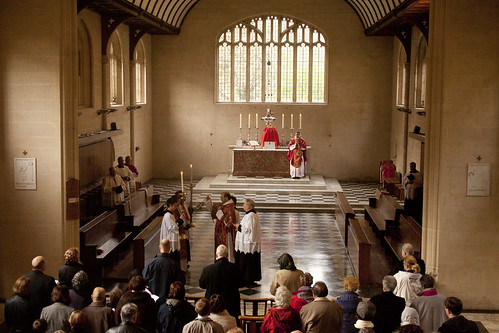
The Gospel.
There were about 120 at the Mass, inlcuding representatives from Oxfordshire County Council and the Oxford Preservation Trust. With Malmaison, the hotel occupying the site, they have been extraordinarily helpful in making sure the plaque was in place in time, in the right place and with appropriate wording. The plaque is in fact one of a series planned for the Oxford Castle site.
There was also a delegation from Blessed George Napier School, a Catholic secondary school near Banbury, led by the Deputy Headteacher. It was excellent to have them there, as the school exemplifies the local 'cultus' of Blessed George Napier, which the staff and students clearly take very seriously. By chance I met a recent graduate of the school over the Summer who recalled being told the story of Bl George Napier while there; it clearly made a deep impression on her.
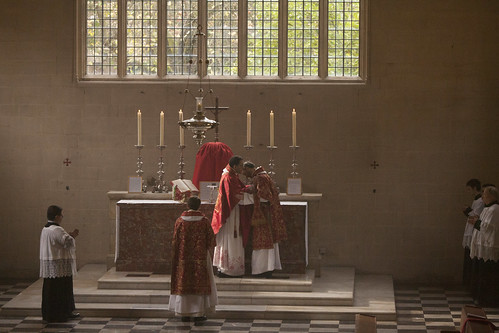
The Kiss of Peace.
Napier was very much a local man: born in Holywell Manor in 1550, where his family were long established and continued to live for some time after, his father was a Fellow of All Souls and he himself attended Corpus Christi College until ejected for being a Catholic. Details of his life are sketchy but we know he spent 8 years in prison in London for his faith, and at the reletively advanced age of 46 joined the seminary at Douai. He was ordained and was back in Oxford ministering to the faithful in 1603.
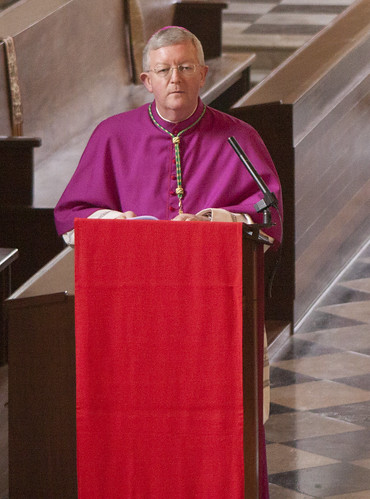
The Most Reverend Bernard Longley, Archbishop of Birmingham, preaching.
He looked after the Catholics of Oxfordshire until his arrest in 1610. He was arrested while tramping from house to house outside Oxford taking communion to the housebound. He seems to have been based at Holywell Manor, where his brother was living. In those days Mass was said in a number of secret locations, including several pubs. The cellars of The Mitre, one such location, can still be seen today.

While in prison in Oxford Castle he further offended the authorities by reconciling a fellow prisoner to the faith. This man, a highwayman called Falkner, proclaimed this fact before his own execution. And so Napier was condemned, for crime of being a priest, to hang as a traitor.
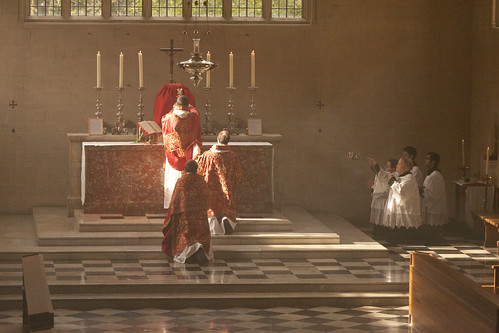
Archbishop Longley preached at Mass on the nature of martyrdom, and after a buffet lunch led the procession from Carfax Tower to the Castle, and then back to Blackfriars. There were about 80 people in the procession, and on the way to the Castle we sang the Litany of the Saints. At the Castle Archbishop Longley blessed the plaque, and we sang the Te Deum. As we processed back to Blackfriars, we sang some vernacular hymns and the Litany of Loreto.
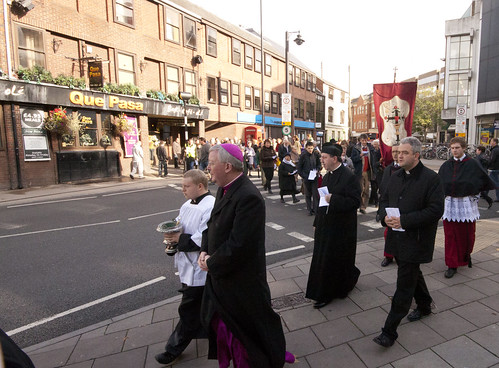
Processing from Carfax to Oxford Castle.
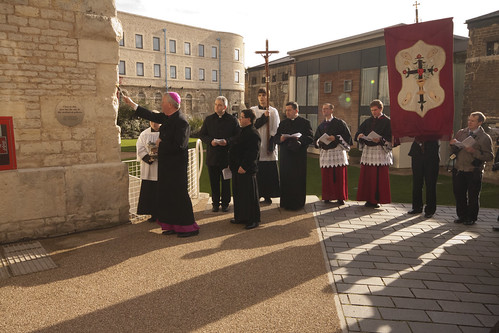
Archbishop Longley blessing the plaque.
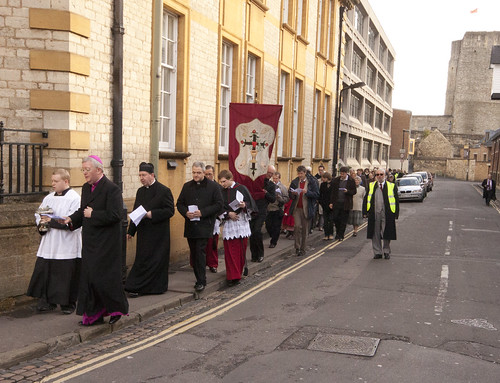
Processing from the Castle back to Blackfriars (Tidmarsh Lane shown)
The procession was most impressive, with the large and beautiful banner of the Five Wounds which has been adopted by the newly founded Sodality of the Five Wounds, based at St Bede's Clapham Park (where the banner belongs). The Sodality provided the excellent marshalls.
Also present were two members of the Confraternity of the Precious Blood, in their black and red robes. These are better known as the Brothers of the Little Oratory, based at the Brompton Oratory in London.
With the Schola Abelis providing support for the singing, we had the best procession yet.
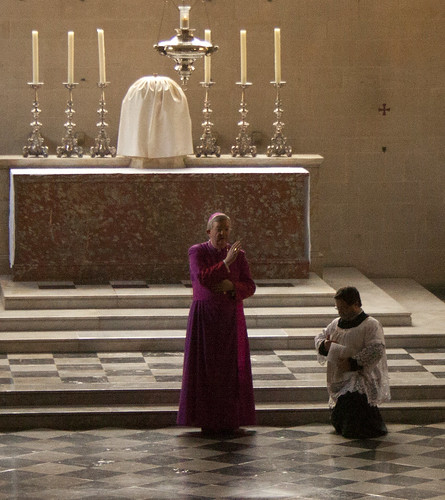
Archhishop Longley gives us his blessing on return to Blackfriars.
At the end of the procession Archbishop Longley read the prayers for the end of a procession of thanksgiving - for that is what it was. In part, the translation runs: 'We thank Thy most gracious Majesty for the gifts that Thou hast bestowed upon us, and as Thou hast answered the prayers of those who petition Thee, we impore Thee in Thy clemency to forsake them not, but to prepare them for the rewards to come.'
After that, Archbishop Longley gave us his episcopal blessing. All these prayers and blessings the Archbishop sang: he has a fine voice and was a singer before joining seminary.
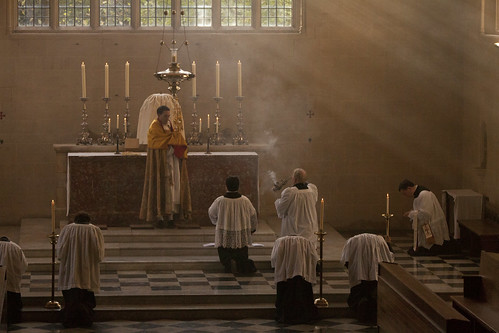
Benediction, led by Fr Thomas Crean OP.
We then had Benediction, led by Fr Crean.

This plaque, now blessed by our local Ordinary, represents the conclusion of a very long project of mine, to mark the two sites of martyrdom in Oxford in an appropriate way. I began the process in 2005; the first plaque, in Holywell Street, was installed and blessed at the Oxford Pilgrimage in 2008. On that occasion I had to get the necessary permissions from the owner of the building (Merton College), and planning permission, after seeking initially to have the plaque done through the Blue Plaque scheme. We ended up with a much more impressive plaque than one of the 'Blue Plaques', which commemorate everything from obscure novellists to Oxford marmalade, but raising the necessary money for it was a headache.
On this occasion all the adminstrative aspects were dealt with by others, but they were kind enough to accept my input on the position and wording of the plaque, and the timing of its installation. (It was installed on the Thursday before the blessing - phew!) However it was still a long haul - I started my enquiries with Oxford Archaelogy and Oxfordshire County Council in 2008, and by the end I'd also had a great many phone calls and emails with the Oxford Preservation Trust and Malmaison as well. Everyone, I must say, was most helpful and professional, but these things are complicated and time consuming.
Archbishop Longley made the point that the spot marked by the plque is a 'holy place'. It certainly is: the places where the martyrs shed their blood are holy places. This is why it was so important for Catholics that they be marked; otherwise most people passing by would simply have no idea. We will continue to have pilgrimages to these places, and will now have something to see when we get there. But as well as the formal annual pilgrimage, the sacrifice of our great predecessors in the Faith will continue to bear witness to the casual passer-by, just as it did in the the reigns of Queen Elizabeth I and King James I.
No comments:
Post a Comment